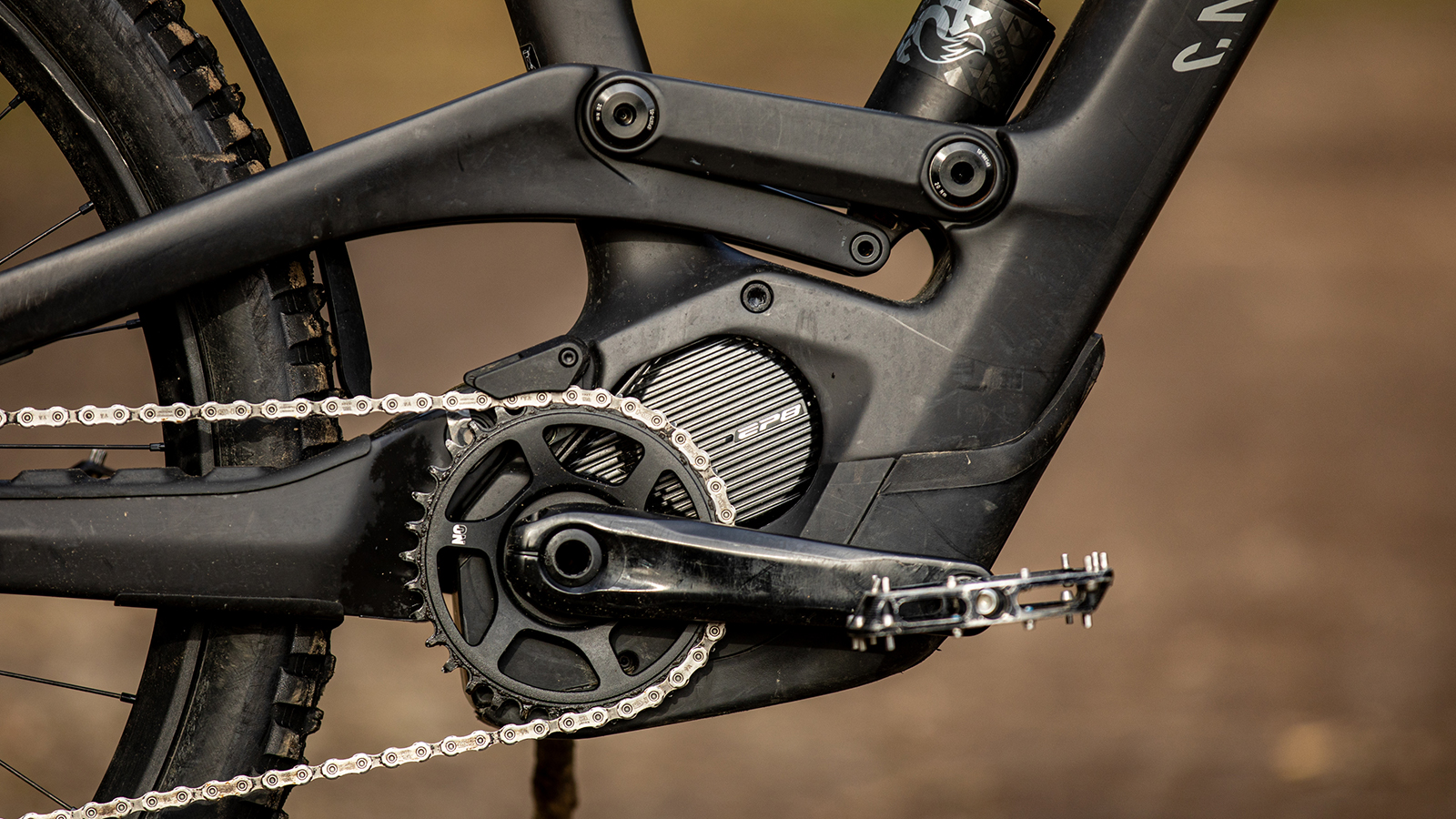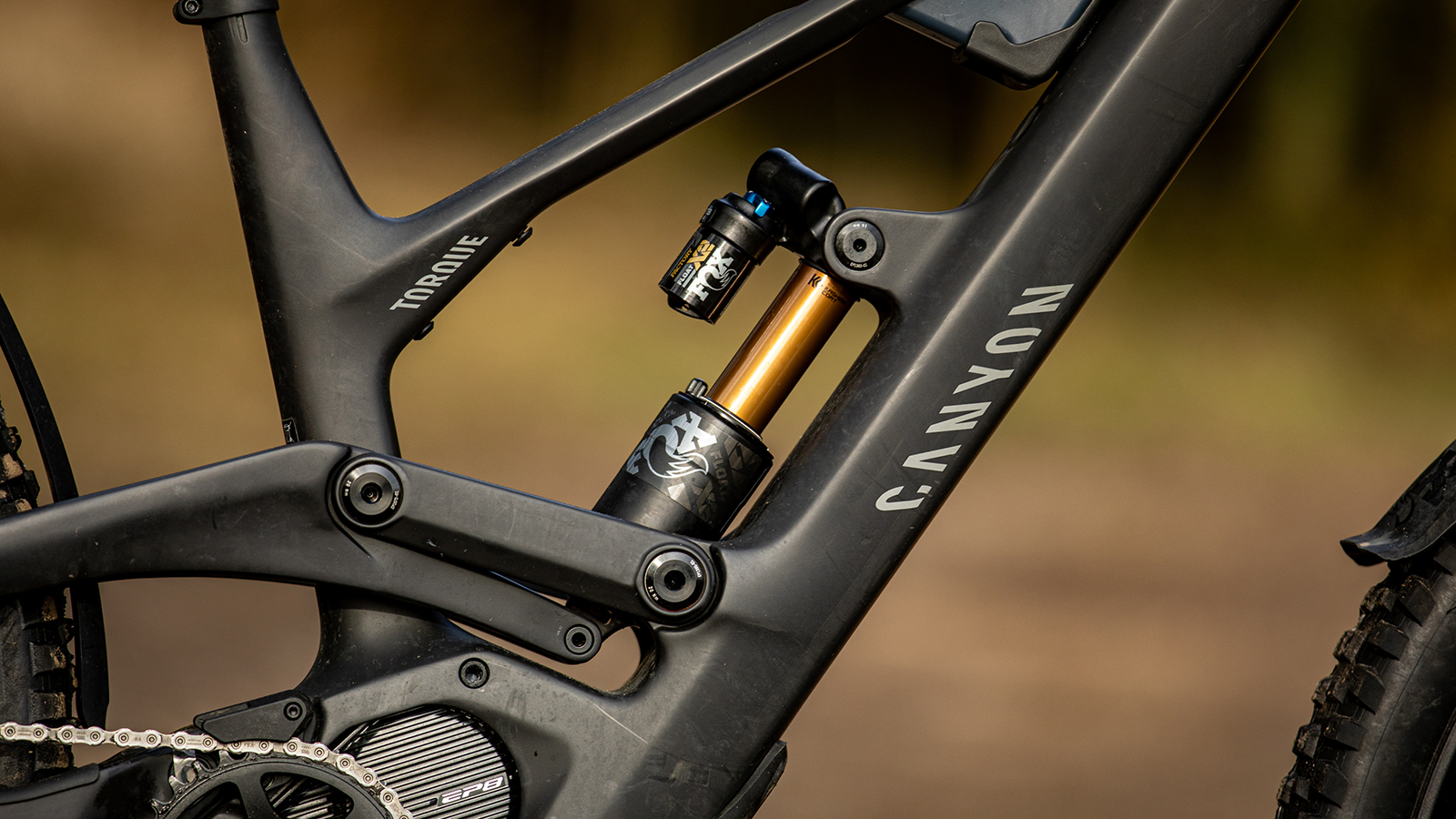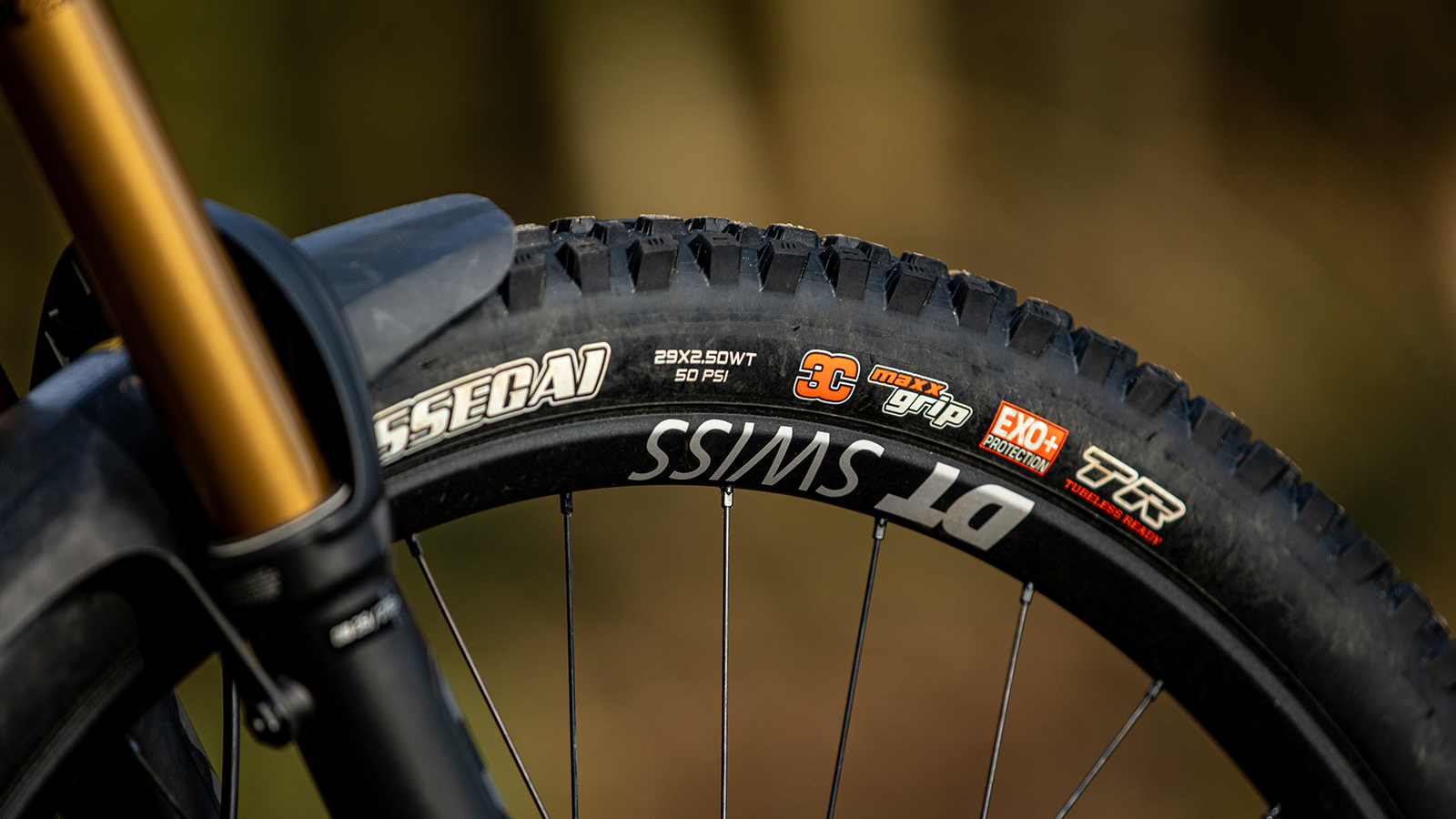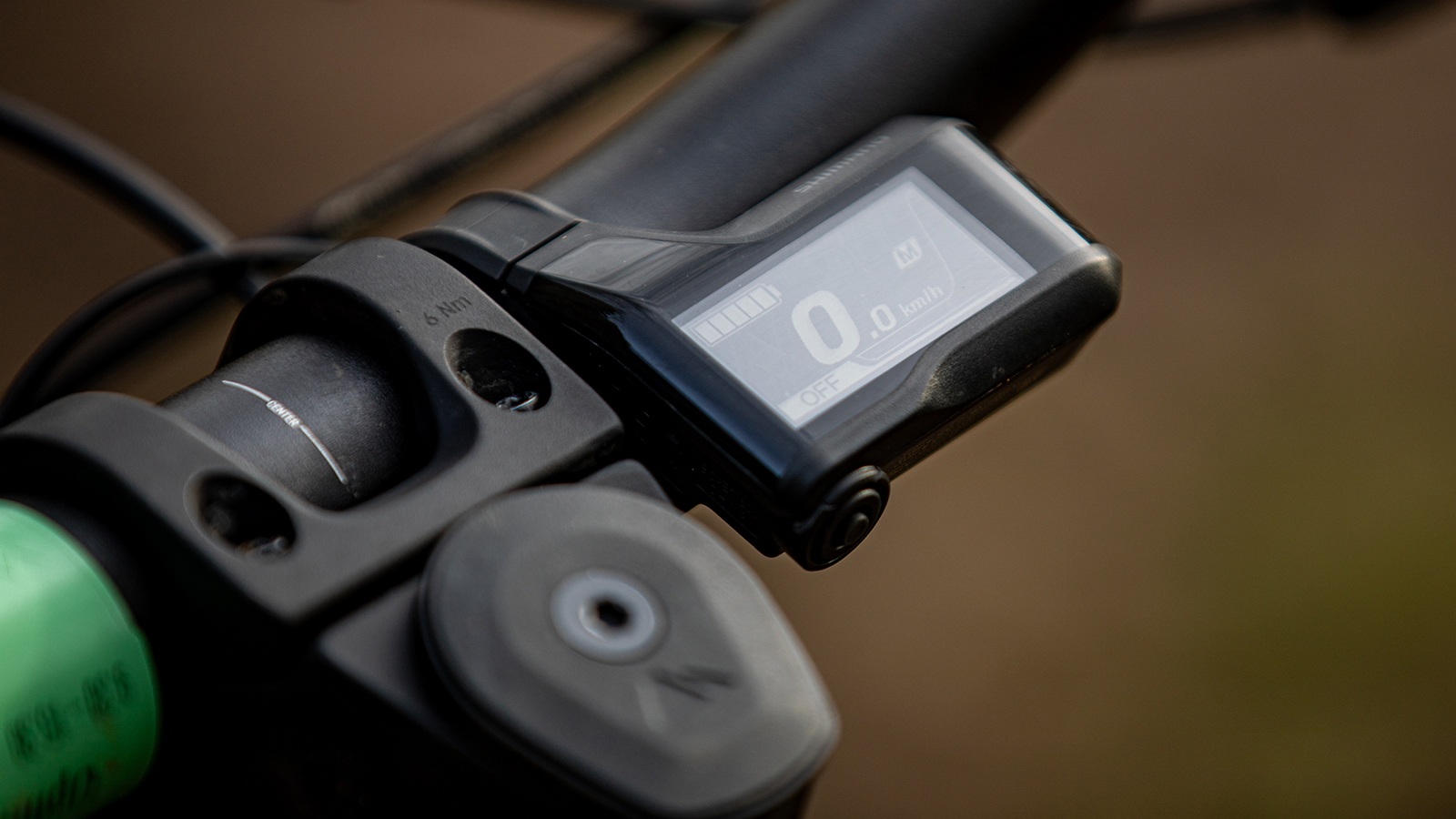
Canyon’s Torque first grabbed my attention as a 27.5in wheeled freeride pedal bike a few years back. Ready to hit massive jumps and whip down the best bike parks, it felt a bit like a motocross bike without an engine, and I loved it. Well, with a 600w peak power Shimano drive unit, this latest Torque:ON might just be that bike with an actual engine – it's definitely up there with the best electric mountain bikes.
The electric Torque is such a big hitter, I heard on the grapevine that Canyon Collective team manager, Fabien Barel, has been timing runs with it against the German brand’s Sender DH rig with surprisingly close results. On some of the hardest tracks used for off-season team camps, Fabien was apparently consistently clocking within a second per minute off Canyon’s latest factory-tuned DH bike. And that’s on a bike with 175mm rear and 180mm front travel, rather than 200mm at each end on some of the rockiest test tracks in Europe. Blimey!
Ex-multiple World Champion, Barel, won the UCI E-Enduro World title outright last year, beating a load of current downhillers and enduro shredders in the process and has a big part in the development of Canyon’s gravity e-bikes. The Frenchman actually mostly races the (shorter travel) Strive:ON, since that bike has the latest Bosch CX Race motor that currently offers the most capacity for tweaking. Racers like Fabien look for extended overrun times, precise tuning optimization and pushing engine software to the limits as crucial when racing with timed uphill stages in the mix.

This Torque:ON instead uses Shimano’s latest EP801 motor, but the great news for those not racing uphill against the clock (where Bosch seems to have the slight edge in sheer grunt at lower cadences) is Canyon’s proprietary battery solutions offer up to a massive 900Wh capacity. This delivers enormous range compared to Bosch’s 750Wh maximum using its own PowerTube batteries (without mounting extra range extenders).
I’ll be delving into the subtle differences of both these systems in a future comparison feature and also reviewing the Canyon Strive once I’ve put a few more rides into it. But the short story for regular riders so far looks like the Bosch/Shimano motor choice isn’t totally clear cut; especially considering Canyon’s mammoth battery capacity with Shimano’s latest EP801 here.
Even with the downtube rammed with cells (Canyon also offers a smaller lighter power pack for less cash), the CF 9 Torque:ON in size Medium only weighs 24.3kg on my scales. Blimey yet again. I mean look at the state of this thing; it looks built like a tank, but clearly isn’t a tank, so let’s take a deeper dive into Canyon’s electric freeride machine.

Design and geometry
More so than perhaps any other e-bike, Canyon’s futuristic styling is pushing design language further away from traditional skinny-tubed push bikes. With a Category 5 (DH bike) rating, there are huge pieces of swoopy carbon and beefy links and pivots, with the biggest sculpted downtube section housing the internal power pack that reaches right up inside to the head tube. A rubberized button on the downtube turns the bike on and off.
Like the Spectral:ON, Canyon offers either 720Wh or the 900Wh battery here, and a clever modular release sees the battery slide out underneath to charge indoors. With a 5mm Allen key, you could in theory swap between options depending on whether you prioritize maximum range or less/lower down weight. The bigger capacity costs a fair bit more at checkout and adds 900g, which my rudimentary maths tells me means the smaller battery bike would weigh 23.4kg – pretty incredible for an e-bike this capable.
Aside from the chiseled carbon chassis itself with sunken in-line shock, one of the most recognizable Torque:ON features is its fuel tank-style water bottle. Canyon’s engineers must have been dreaming about motorbike design while positioning a triangulated 650ml hydration station in a top tube slot behind the head tube like this. It uses both a pop-in housing and wrapover clasp strap for extra security and is fully removable, but I reckon the frame looks a little odd with a ‘hole’ in the top tube without it, so most riders will just leave it empty if they don’t need a drink or want an extra 650g of weight high up on the bike.

Pumped up and lairy it might be, but Canyon’s latest e-Torque chassis is also remarkably light. Entirely carbon, at 3.35kg, it’s claimed 1.5kg lighter than its predecessor while also being much stiffer – 7 percent at the front triangle and a huge 25 percent at the back end. Being so low slung obviously doesn’t just make the bike ‘look’ lighter then.
Canyon has also gone to town with the Torque’s ‘modern sizing’ aspect. With 475mm reach, this is one of a handful of bikes I choose a Medium rather than Large in, and sizes start at 450mm in Small and stretch forwards in 25mm increments all the way up to a huge ape index accommodating 525mm in XL.
Top tubes are really low throughout sizes and kink upwards into stubby seat towers, so you can size up and not get penalized between your legs. Chainstays are likewise stubby at 445mm in all sizes, which is pretty short for any full-fat e-MTB and also wrapped in dense rubberized padding top and bottom to quieten the ride.
The Torque:ON might look slightly different to the rest of the Canyon family but still uses a 4-bar suspension design like most. The shock is connected by seat tube ‘extender rods’ at its lower eyelet with beefy wrapped carbon links around it, the main pivot sits slightly rearward above the motor (and roughly in line with the 34t chain ring) and there’s a chainstay pivot in front of Boost 148mm rear axle. All pivots and hardware are built tough to ensure the chassis exceeds Canyon’s Cat 5 ‘Gravity’ rating in in-house fatigue and stiffness testing.

Components and build
With better wheels than the previous generation, Fox Kashima suspension and Shimano XT kit throughout, the component package is totally dialed. Factory-level Fox kit, XT drivetrain and 4-pot brakes (with 220mm front rotor) are totally proven and, as mad as it sounds for a 7K+ bike, this CF 9 model looks pretty good value to me in its category.
There’s the four-way adjustability you’d expect on both the X2 (DH-level reservoir shock) and 38 Fork, that means tons of damping adjustment for all rider weights and pretty much class-leading control and performance.

The better wheels come in DT Swiss HXC 1700 flavor, replacing Sun Ringle Duroc SC wheels previously that I’ve dented on test bikes before. At just over 2kg a pair, they’re especially tough for the weight and have a solid freehub ratchet design that can handle e-bike torque and mileage.
DT Rims are 30mm internal and Canyon mounts the sorted Maxxis combo of Maxx Grip and Maxx Terra in EXO+ casing front and Double Down rear respectively. I had zero issues with it, but this pairing might be skimping in thickness if you live somewhere with serious DH terrain, rocky trails or ride at the speeds the Torque encourages.

Canyon’s own brand bar (800mm), stem (45mm), Iridium dropper seatpost and lock-on grips are all decent performers, but the Fizik Alpaca saddle was a different story. Listed as ‘Unisex’, I’m not sure I’ll be having much sex for a while after multiple full days on this rock-hard flat perch. I found it extremely uncomfortable to the point of causing numbness, slippy when muddy and it would be the first (and only) thing I’d swap out here. One benefit of a pancake flat saddle I guess is it’s (too) easy to slide your bum off the back to get weight rearwards on the many descents the 900Wh battery can access.

Motor and battery
Shimano's latest generation EP801 ups peak power from 500 to 600 watts over the previous EP8. It boasts 80Nm of torque and 400 percent pedal assist and also seems to be doing a far better job of handling wet weather and jet-washing owners without dying an early death on some frame designs like its predecessor.
This extended performance results from refinement inside the motor’s casing and better seals on electrical connections in zones at risk of moisture ingress and contamination. The latest EP801 is also really quiet compared to many rivals – and that includes muting the rattle that cursed the EP8 – I didn’t experience any of the old Shimano clunk here like the older motor.
Power delivery is very natural and neutral, but the rider has to input more watts themselves and pedal a marginally higher cadence to achieve the same peak power as Bosch’s Performance Line CX unit I’ve tested a lot lately. Shimano’s three power modes are tunable in the brand’s E-Tube app and it offers one of the cleanest handlebar screens (removable) and mode selector buttons on the market.
Another big Shimano bonus is being one of the few motor manufacturers allowing bike brands to develop their own battery options, so you can get over the 630Wh ceiling of the brand’s own biggest capacity. Canyon’s modular solutions for example have a high energy density and the largest allows for huge rides with over 2,000m climbing for most riders (up to 90kg in my rough calculations) if you’re careful with the power usage.

Ride, handling and performance
I’m obviously not saying I was getting this bike to anything like the kinds of limits Fabien and the Canyon sponsored athletes are, but, bloody hell, you don’t exactly need to be a detective to suss out this Torque:ON is an incredibly capable machine from the very first ride.
My baptism of Torque fire started at nine o’clock in the morning on a mate's riding weekend up at Innerleithen. Riding started as it would go on with our ex-Elite enduro pal guiding like all ‘good’ mates would; namely trying to scare the bejesus out of visitors by flexing local knowledge and taking us down the hardest tracks possible.
The Torque:ON was literally fresh out of Canyon’s fancy cardboard box and I was fresh out of bed as we plunged down dark Scottish woods and chutes for breakfast. Having only set tire and suspension pressures (and not having the regulation 750mm sawed down bars to squeeze through Inners' tight trees), you’d want to be on the kind of bike that is more than up to anything in this scenario. And thankfully, the Torque:ON is exactly that kind of bike.
After one sketchy half asleep run, I added around 10psi to the fork, wound rebound damping off at both ends and never touched the suspension again. By run two and run three, I’d let a couple of psi out of the front Maxx Grip Assegai to up grip levels from amazing to ridiculous and was all set. I then spent the rest of the day moving up the pecking order of mates to take the back wheel of the local, and strongly suspect the bike had more to do with this than I’d care to admit.
This Torque:ON is basically the older analog Torque I loved years ago with a 900Wh battery in its belly so you can ride all day and double down on the best tracks. It’s super reactive and lively so you can drive it side to side with your feet and never feel like a passenger, even on the hardest tracks. The range is ridiculous too and using mostly Eco and a smidge of Trail up the steepest climbs, I managed 1,900m of climbing and 46km distance (99 percent off-road) and still had two bars of battery left, which is a pretty crazy result.
There appears to be minimal compromise in terms of handling either as the Torque never feels top heavy or hard to chuck about, even with the 650ml water bottle high up and a heavy battery extending right up to the head tube. The opposite is true in fact, which had me musing on how the weight up there might actually be improving the sensitivity and grip of the front fork by tweaking the sprung/unsprung ratio at the front tire, but that’s a thought for another day…
In terms of raw speed, once you get on really rough fast straights you can just let go of the brakes and absolutely haul on the Torque:ON. It’s the kind of machine that tests your bravery and just devours rough terrain without shaking the rider about. Multiple times I found myself visibly gaining on other riders on long straights where it just steamrollers through chop, and then being very thankful it slows down so fast and effectively for a full-fat e-bike, so I wasn’t smashing into back wheels coming into corners.
This braking control is mirrored by great tracking and grip climbing too (aided by a 27.5in rear tire always having more traction up and down than 29in to me), so the Torque:ON never feels like it’s dragging you down the steepest sections in an uncontrolled way like some heavy e-bikes. And this is while remaining much livelier and more dynamic than something like the Whyte E-160 I recently reviewed that’s slightly calmer, safer feeling and more glued to the ground, despite having less travel.

Unsurprisingly considering Barel’s input, there’s more than a hint of highly tuned race bike here and this isn’t your bog standard ‘safe but largely unreactive’ e-bike at all. With chassis and BB super low down between legs, you just kind of lean on the rock-solid front end and load either handlebar tip in the lean direction you’re after and the rear will calmly carve, skim and follow. It’s tight and supportive, but not to the extent it eats into grip and fires off edges or catches you out on shiny exposed roots or angular rocks. The whole effect is not a million miles away from snowboarding somehow. You feel like you’re surfing down the trails on a supportive platform with feet really sunken and the perfect amount of feedback from terrain to flick and play on the edges without being so mushy you can’t connect to the nuances in the terrain and generate speed and excitement.
Being so low down brings one inevitable compromise, which is occasional pedal strikes even with 165mm cranks. You do it a few times on technical climbs, which can be annoying but not that dangerous, but on really rough descents you need to be conscious of where you try and smuggle pedal strokes and to keep cranks level crossing big root webs and down drops and ledges too. The BB being so low meant on one massive high-speed bucket turn out in the open at the Golfie, I accidentally grounded my outside (!) foot on the floor in a berm as the bike was so leant over and I had the outside crank down. I’m putting that down to the Torque giving the confidence to hit any berm at warp speed, rather than any design inherent flaw and the price you pay for such reactive and precise handling. I loved the cornering carve you can achieve on the Torque:ON, but you definitely need to keep an eye on crank position if you ride so hard you’re punching right into the deep rear suspension.
The Torque:ON can manual and jump great and is basically a one-stop gravity e-bike solution that you can ride all day long if you’re careful to conserve battery. It’s pretty much as flickable as many regular enduro rigs, but it arguably offers more of a riders'/rippers' attitude than a super-stable and calming ride for less experienced riders. The chassis is very solid and precise, but you can also easily tune the suspension from preppy and poppy through to duller and more muted if you’re after maximum stability and, let’s face it, there’s a ton of cushioning here to mask multiple riding sins.
Yes, this bike can be boring and slow (no more so than most full fat e-bikes) on mellow terrain and the weight is noticeable tracking over repeated roots and broken up trails if you haven’t got gravity on your side. But everything Canyon’s earlier generation Torque promised minus the motorbike motor is here in spades, and this is one of the most fun e-bikes I’ve tested so far.

Verdict
Looking a bit like a concept motorbike from an Italian designer’s drawing board, Canyon’s Torque:ON CF 9 is the best out-of-the-box long travel e-bike I’ve ridden. In size Medium, the handling is superb and it rides so much lighter (and is so much lighter) than you’d imagine. The massive 900Wh battery doesn’t impact on ride quality and means you can cover huge distances and elevations on one charge.
Stiff as hell, the Torque:ON is low slung and reactive, and with grippy supportive suspension, rewards dynamic precise riding. The sunken shape gets rider center of gravity right down low, so you feel assured jumping big hits and skimming down technical trails and bike parks, but it can also save your skin if you pootle down steep difficult trails above your pay grade.
With true DH-bike capability, the Torque:ON obviously doesn’t fully open up on easy trails, so you need to show Canyon’s rig the gradient, speed or trail technicality and hold the throttle wide open to make it really sing.
Test conditions
- Conditions: All the weather, from bone dry, tire knob-flexing high forces to nasty winter slime and slop
- Terrain: Everything from the steepest and hardest tracks at Innerleithen, Scotland to local moorland rocky descents and hand-cut berms, jumps and local enduro tracks. Also rode the new red and black jump lines at Glentress, Scotland which have higher speed DH sections
- Temperature: 0 to 15-degrees C. UK winter temps
Tech specs: Canyon Torque:ON CF 9
- Discipline: Trail/enduro
- Price: (Canyon US doesn’t offer this exact model, but CF Roczen Special edition is $8,999.00) / £7,149.00 plus box and shipping (£18.99 and £49.99) = £7,217.98 / €7,499.00 plus box and shipping (€19.90 and €39.90) = €7,558.80
- Frame: Canyon Torque:ON full carbon Cat 5. 175mm travel
- Fork: Fox Float 38 GRIP2 Factory 180mm 44mm offset
- Shock: Fox Float X2 Factory
- Head tube angle: 63.5 degrees
- Seat tube angle: 77.5 degrees
- Chainstay: 445mm
- Wheelbase: 1,276mm
- Reach: 475mm
- Weight: 23.4kg (actual)
- Drivetrain: Shimano XT, Shimano Hollowtech E-MTB cranks 165mm, Deore XT cassette, Canyon 34t chainring, XT 12-speed chain
- Motor: Shimano EP801
- Battery: Canyon-designed 900Wh
- Brakes: Shimano XT 4-pot. 220mm front and 200mm rear
- Wheels: DT Swiss HFR 1700
- Tires: Maxxis Assegai F Maxx Grip EXO+ 29 x 2.5in, Maxxis Minion DHR II Maxx Terra DD 27.5 x 2.4in
- Seatpost: Canyon Iridium Dropper 150-200mm
- Saddle: Fizik Alpaca X5
- Bars: Canyon Alloy 800mm x 35mm diameter
- Stem: Canyon:ON e-mtb 45 x 35mm
- Rival products: Whyte E180, YT Decoy MX 4, Nukeproof Megawatt







